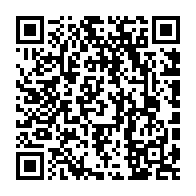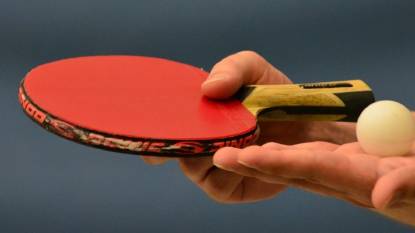Basic Equipment Needed to Play Table Tennis
By: Mark
April 4, 2019 | Updated: December 21, 2025
Key Takeaways:
- The basic equipment needed for playing table tennis includes a table with a net, paddles for each player, and a ball.
- The blade is the actual paddle, while the rubber is the type of covering that coats the paddle and acts as its playing surface.
- Blades are categorized based on their speed and are typically defensive, all-around, or offensive.
- Inverted rubber is stickier and recommended for beginners, while pimpled rubber is used by defensive players and is not recommended for beginners.
- Table tennis balls have a rating system that uses stars, and three-star rated balls are the highest quality.
- Table and net regulations for game play include a table that is nine feet in length, five feet wide, and two and a half feet tall, and a net that is six inches high and stretches the full width of the table and six inches off either side.
- Equipment maintenance is important to ensure that it lasts for many years, and there are various products available to help with this, such as edge tape, sponges, and protective cases.
| Equipment Needed | Description |
|---|---|
| Table Tennis Tables | A table designed specifically for table tennis, typically measuring 9 feet in length, 5 feet in width, and 2.5 feet in height. |
| Nets | A net that stretches the full width of the table and is 6 inches in height. |
| Bats | Also known as paddles or rackets, these are used by players to hit the ball back and forth across the table. |
| Balls | Small, lightweight balls used in table tennis. They are typically made of celluloid or plastic and come in various colors. |
| Shoes | Indoor shoes with non-marking soles are recommended for table tennis to prevent damage to the playing surface and provide good traction. |
| Clothing | Comfortable, breathable clothing is recommended for table tennis. Many players wear athletic clothing, such as shorts and a t-shirt or a tracksuit. |
When it comes to playing table tennis, the basic equipment you will need is pretty standard - the table with a net, paddles for each player, and a ball. However, there are many companies that produce the standard equipment, and choosing the right table tennis products from manufacturers is incredibly important.
The Rubber and the Blade
If you are a table tennis aficionado, you already know the terms "rubber" and "blade" when speaking of your table tennis paddle. For those of you new to the sport, a definition might be required. The blade is the actual paddle; the rubber is the type of covering that coats the paddle and acts as its playing surface.
Blades
There are many different types of blades, and they are usually categorized based on their speed, which depends on a combination of both blade and rubber. The main types include:
- Defensive Blades
- All-Around Blades
- Offensive Blades
Defensive blades are generally slower in speed, but they give you the most amount of control. They are great for beginning players or players who generally play defense.
All-Around Blades are about mid-level in speed and control. These are used by players who play offensively and defensively in equal measure.
Offensive Blades are hands-down the fastest type of available blade, but the enhanced speed means you have less control over them. These are used by mostly offensive players and should not be used by a beginner.
Although table tennis rules state that the majority of any blade must be made up of wood, other materials - most notably acrylate and carbon - are used in the middle of the blade to achieve different effects. However, if these materials are visible, the blade is rendered illegal. A new material known as glass fibre is quickly gaining popularity in the table tennis world. It adds both stability and speed to the blade while reducing its weight. It also enlarges the "sweet spot" of the playing surface but still feels like a typical wooden blade.

Rubber
There are two main types of rubber - inverted and pimpled. Inverted rubber, sometimes referred to as smooth rubber, is actually just pimpled rubber that is inside out, so that the underside of the pimples is facing outward over a spongy layer. The spongy layer serves to add either better control or faster speeds, depending on exactly how it is made. Inverted rubber is also stickier than pimpled rubber, which helps players make better spin shots. Beginners are encouraged to use this rubber because it adds more traction and makes it easier to hit the ball in the desired direction.
Pimpled rubber
Pimpled rubber is covered in something called "pips," which are basically tiny cylindrically-shaped objects that give the paddle an uneven playing surface and help players who prefer to play defensively. The so-called "pips" can be either short and thick or long and thinner, although rubber with long pips is currently being contested as illegal in league, tournament, and championship games.
Defensive players are generally the only players who use pimpled rubber, and it isn’t recommended for beginners. When playing table tennis in your garage, the color of your paddle doesn’t really matter; however, in league games, one side of your paddle must be covered in red rubber and the other side in black. The rubber also has to be two millimeters thick or less (four millimeters or less for rubber and sponge combos) to be legal.
Furthermore, there is a system of rating for rubber; it is based on both spin and speed. This system is a standard 1-10 scale, with ten being the quickest and most easily spun. If you are new to the game, don’t worry. Most manufacturers allow you to test out their products before purchasing them. There are also many online and real-world communities where players can get together and talk about and compare various brands of products.
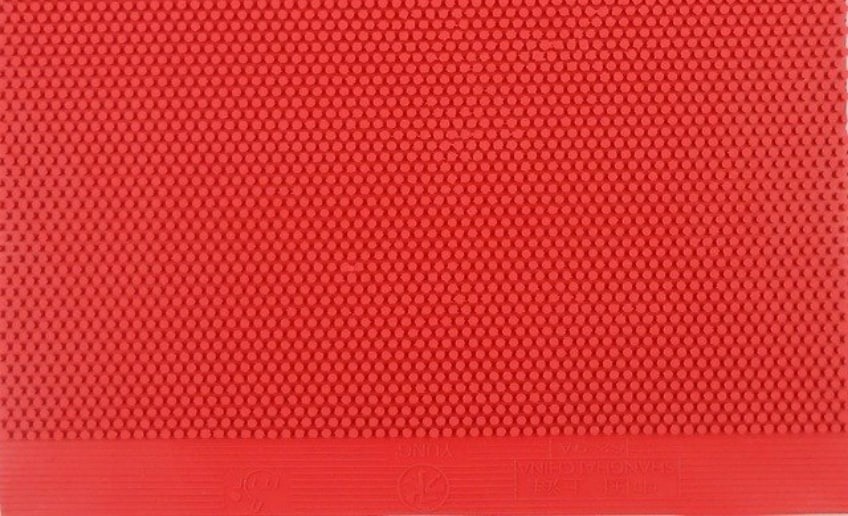
Changing the Rubber
Applying your own rubber or changing your paddle’s old rubber can make a first-timer nervous, but it really isn’t that difficult. For replacing old rubber, follow these simple steps:
- 1. Start at the bottom edge of the old rubber and pull the entire rubber off the paddle.
- 2. If the rubber does not peal easily, use fingernail polish remover or any other form of acetone to help remove the glue.
- 3. Once the rubber is gone, take a gently abrasive cloth or pad to sand down the paddle until the glue is gone and the playing area is smooth.
- 4. Remove the new rubber from its package and lay it face down on a clean, dry surface (preferably plastic).
- 5. Apply a thin coat of glue to your paddle and let it dry. The best choices are paddle glue specifically made for paddles, rubber cement, or chack. Elmer’s glue, wood glue, and super glue will not work.
- 6. Add a thin coating of glue over the entire backside of your new rubber.
- 7. Allow the glue to dry and then add a second coat.
- 8. Before this coat of glue dries, gently attach the rubber to the playing surface of your paddle. (Start from the bottom and work upwards.)
- 9. Place the paddle on the edge of a flat surface with your newly added rubber side facing upwards. Allow the handle to hang off the side of the flat surface.
- 10. Use a rolling pin or similarly shaped item to roll over the rubber and remove any air bubbles that may have formed.
- 11. Cover with a protective sheet and weight it down with something heavy.
- 12. Once the glue has set, turn your paddle upside down.
- 13. With a razor, trim off any excess rubber around the edges of your paddle.
During this last step, be sure to use cardboard or some other material underneath your paddle so that you don’t damage your countertops, tables, or whatever surface on which you are working. Furthermore, be especially careful not to nick your blade or cut your paddle while trimming off the excess rubber.
Guide to Balls
Like rubber, table tennis balls also have a rating system, but this system uses stars instead of numbers 1-10. The highest-rated balls always have a three-star rating.
Because table tennis balls are relatively inexpensive - the most expensive ones are usually only a dollar or so per ball - you should always choose balls with three-star ratings. Balls with lower ratings are prone to breaking or denting. High-quality balls can last a long time, as long as they are cared for properly.
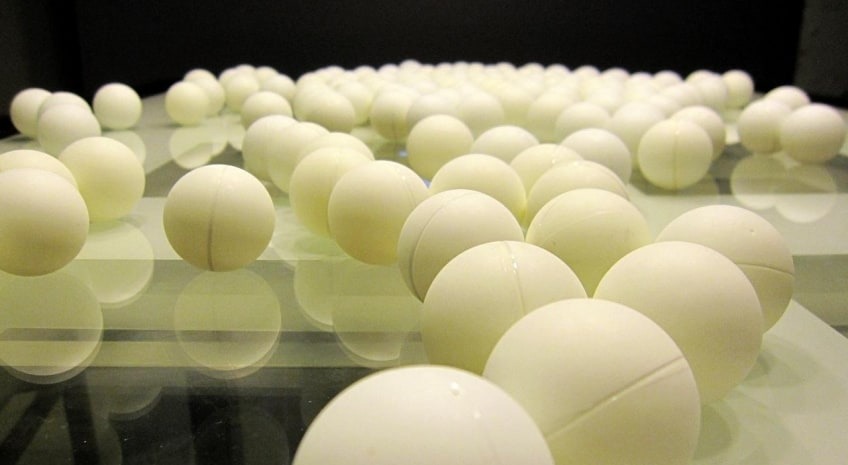
Some steps to remember when taking care of your table tennis balls:
- Keep them out of direct sunlight
- Avoid excess heat
- Avoid excess moisture
- Pick them up immediately if they are dropped to avoid stepping on them
If you do those four simple things, high-quality balls can actually last a long while. Ball colors aren’t important when practicing; however, you might want to use orange or white, which are the two legal colors for competition games, so that you can get used to seeing them and picking them out of background colors.
Nets and Tables
It is important to ensure that your practice table and net are the same size as a regulation set for games so you don’t get used to practicing on the wrong sized table. Tables should be nine feet in length, five feet wide, and two and a half feet tall. As for the net, regulation height is six inches, and it must also stretch the full width of the table and six inches off either side. The surface of regulation tables is usually either green, navy, or black and must be non-reflective.
Take a look at our recommended lists of Indoor and Outdoor Table Tennis Tables from the main menu at the top of this page.
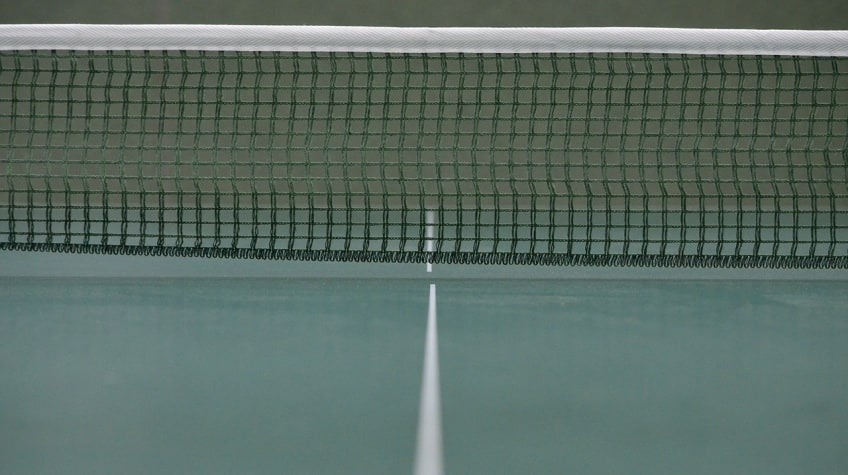
Despite all nets and tables having to adhere to these regulations, they still come in widely varying qualities. In fact, some of the highest quality tables can cost upwards of $1000! A good net can set you back another $100, as well. For most people who want a table in their homes, the cheaper tables work fine. For professionals needing a practice table in the home, though, higher quality tables are needed. Tables should also always be set up on some type of flat, hard flooring, such as concrete, linoleum, or wood.
Where to Buy
Because table tennis doesn’t have the prestige and following of other sports, such as baseball, football, and basketball, buying good, high-quality table tennis equipment in America can be difficult. If sporting goods stores sell table tennis equipment at all, it is usually in the more juvenile, "just for fun" sections of the store.
Paddles are generally sold pre-constructed, which means the rubber comes pre-applied to the blade. This is typical in America, but in other countries where the game is a truly competitive sport, blades are almost never sold with the rubber on them because pro players want to hand-select their rubber and glue it on themselves. These types of blades and rubber are far superior to the cheap, pre-assembled kind popular in America.
Even American tables are sub-par and not worthy of professional athletes. If you are just starting out in the sport and want to buy quality equipment, the initial investment can be expensive. Good, durable blades are around $40 on average, and remember, those do not include the rubber, which can be about $25 or more. A good, regulation-sized table is going to run you about $400, and because they aren’t readily available in America, you're probably going to have to pay some shipping costs, as well. Used equipment is cheaper, but you always need to double check their conditions.
Equipment Maintenance
As long as you take care of your equipment and don’t treat it roughly, it can last a long time. You can even buy things to help you keep your equipment in top shape, such as edge tape to help protect your blades, sponges to clean your rubber, and protective cases for storage.
Nets should be stored properly in a dry, sparsely used area when not in use, and tables should be cleaned before they are put away somewhere dry and safe indoors. *Never store your table tennis table outside! Condensation, rain, animals, and all manner of things will damage it if you do.
Balls should be stored inside a case - not a plastic bag! If you do all of these things, your equipment should last you for many years.
Ping Pong Clothing
As this is a fast-paced and highly physical sport that requires players to have clothing that is comfortable, flexible, and allows for a full range of motion. In addition to comfort, the clothing should also be breathable, moisture-wicking, and lightweight to keep players cool and dry during intense games.
One of the essential features of table tennis clothing is flexibility. Players need to be able to move quickly and easily, and their clothing should not restrict their movements. Great clothing should be designed with stretchy materials, such as polyester or spandex, that allow players to move freely without feeling constricted. The clothes should also have a slim fit to reduce any interference with the paddle or ball.
Another essential feature is breathability. During a game, players tend to sweat, and without proper ventilation, this can lead to discomfort and distraction. Clothing designed specifically for table tennis often includes breathable fabrics and mesh panels that allow for proper airflow, keeping players cool and dry. Some clothing also includes moisture-wicking technology that draws sweat away from the skin, helping to regulate body temperature.
It should also designed to be lightweight, which is crucial for a sport that requires quick movements and agility. Lighter clothing allows for a greater range of motion, which is necessary for players to execute fast and precise shots. Additionally, lightweight clothing can help reduce fatigue during extended matches, keeping players energized throughout the game.
Clothing for table tennis should be designed to prioritize comfort, flexibility, breathability, and lightweight construction. With the right clothing, players can focus on their performance without worrying about discomfort or distractions. By investing in proper table tennis clothing, players can enhance their gameplay, reduce the risk of injuries, and improve their overall experience on the court.
Table Tennis Shoes
It is important of wear proper table tennis shoes while playing the game. Regular training shoes may not provide the necessary features required for playing ping pong. Table tennis shoes are designed with specific features that cater to the needs of players.
- One of the most significant features is the grip pattern. The soles of the shoes are made with a unique pattern that provides excellent grip on the smooth surface of the table tennis court. This ensures that players have a firm footing and can make quick movements without slipping, resulting in better performance and reduced risk of injuries.
- In addition to the grip, table tennis shoes offer support and stability to the feet and ankles. They have reinforced sides that help prevent ankle sprains and ensure that the foot stays stable during lateral movements. The shoes also have a thin layer of cushioning that provides comfort without compromising on grip or stability.
- They are designed to be lightweight and flexible, allowing for a natural range of motion. They are made with breathable materials that keep the feet cool and dry, reducing the risk of blisters or discomfort. Furthermore, table tennis shoes are designed to withstand frequent lateral movements and quick changes of direction, which are essential for playing the game.
Investing in a proper pair of shoes can significantly improve a player’s performance and experience on the court. They offer unique features such as grip, support, stability, cushioning, and flexibility, which are crucial for playing safely and efficiently. Therefore, it is important to choose the right pair and fit for you to prevent injuries and improve your overall performance.
Frequently Asked Questions
1. What is the difference between an offensive and defensive blade?
An offensive blade is designed for players who prefer to play aggressively, with faster shots and less focus on control. A defensive blade is designed for players who prefer to play defensively, with slower shots and more control.
2. What is the difference between inverted and pimpled rubber?
Inverted rubber is a smooth rubber that is easier for beginners to use, as it provides more traction and makes it easier to hit the ball in the desired direction. Pimpled rubber is covered in tiny cylindrically-shaped objects called "pips," which give the paddle an uneven playing surface and are better for defensive players.
3. What is the best type of ball to use for table tennis?
The highest-rated balls always have a three-star rating, and they are more durable and less likely to break or dent than lower-rated balls. The color of the ball doesn’t matter when practicing, but in league games, the ball must be either orange or white.
4. How do I choose the right table tennis equipment for my skill level?
For beginners, it is generally recommended to choose equipment that is easier to use, such as a paddle with inverted rubber and a slower defensive blade. As your skill level improves, you may want to switch to equipment that is better suited for more advanced players, such as a faster offensive blade and a paddle with pimpled rubber.
5. How do I maintain my table tennis equipment?
To keep your equipment in good condition, it is important to store it properly and avoid treating it roughly. You can also purchase products like edge tape to help protect your blades, sponges to clean your rubber, and protective cases for storage. Additionally, it is important to keep your equipment out of direct sunlight and avoid excess heat and moisture.
Choosing a Table Tennis Bat | PingSkills Video
Featured Articles
Dive into in-depth stories, exclusive interviews, and expert advice from the world of table tennis. Discover strategies, player spotlights, and behind-the-scenes insights.
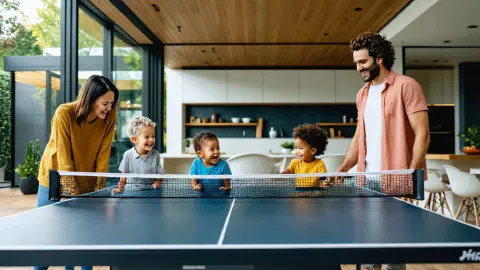
Ping Pong Revolution: How Table Tennis Transforms Homes, Offices, and Communities
Table tennis is uniquely positioned as one of the most versatile recreational activities available today. This comprehensive article explores the transformative impact of ping pong across three …
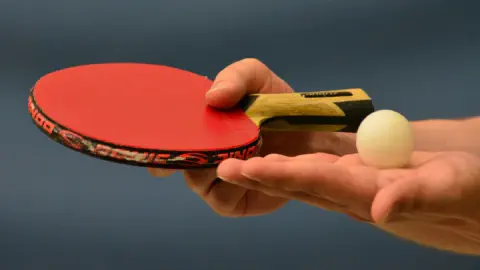
Basic Equipment Needed to Play Table Tennis
What is the basic equipment that you need to get started with playing ping pong? Our guide to the very basic table tennis equipment required to go ahead and start to play. A guide to the basics of …
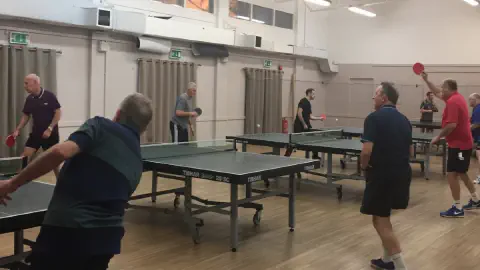
Is Ping Pong Good Exercise? The Top Health Benefits Explained
Table tennis is great exercise both for mind and body. You can use ping pong to keep fit alongside other exercise programs and raise your overall activity levels to lose weight and keep your mind …

Ping Pong Revolution: How Table Tennis Transforms Homes, Offices, and Communities
Table tennis is uniquely positioned as one of the most versatile recreational activities …

Basic Equipment Needed to Play Table Tennis
What is the basic equipment that you need to get started with playing ping pong? Our guide …

Is Ping Pong Good Exercise? The Top Health Benefits Explained
Table tennis is great exercise both for mind and body. You can use ping pong to keep fit …
